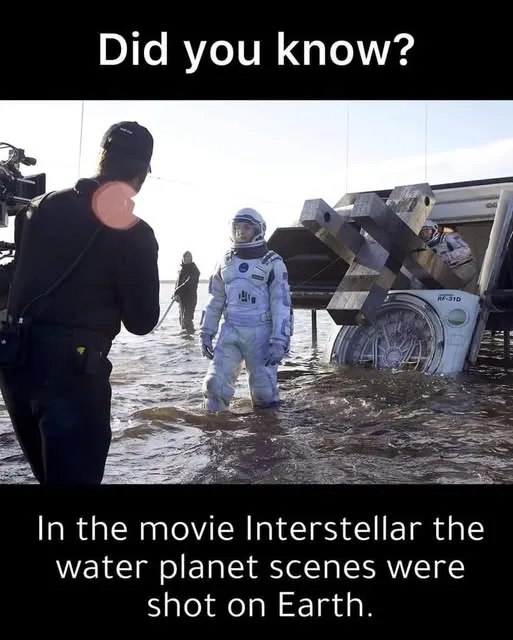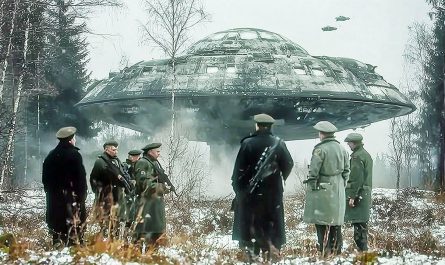When Christopher Nolan’s Interstellar hit theaters in 2014, audiences were pulled into a sweeping, emotional journey across space and time. Among the film’s most memorable moments is the tense sequence on Miller’s Planet — the so-called “water planet” where time dilation means hours on the surface equal years in orbit.

The scene’s unsettling beauty — an endless ocean under a pale, cloud-streaked sky with colossal waves on the horizon — feels otherworldly. Yet in reality, the cast and crew weren’t on some distant exoplanet. They were standing ankle-to-knee-deep in Icelandic tidal flats, battling cold winds, unpredictable weather, and real seawater.
Why Christopher Nolan Chose a Real Location
Nolan is known for using practical effects whenever possible. His philosophy is simple:
“If you can do it for real, do it for real. The audience can tell.”
For the water planet, Nolan wanted:
-
A wide, uninterrupted horizon that could pass for an alien world.
-
Shallow water extending far into the distance to give the illusion of a vast ocean.
-
Natural light and textures that digital effects often struggle to replicate authentically.
Iceland — already a location for other alien environments in the film — had the perfect spot:
Máfabót tidal flats near Klaustur, where the water is shallow for hundreds of meters and the sky often takes on surreal, washed-out tones.
Designing the Set in Real Water
Instead of building the spacecraft interior in a studio and faking the water with green screens, Nolan’s team:
-
Constructed partial Ranger spacecraft models on-site and anchored them in the shallow tidal waters.
-
Designed costumes that could survive immersion, though the space suits became waterlogged and heavy.
-
Used special waterproofing and protective housings for cameras so they could operate at water level.
These choices meant the cast — including Matthew McConaughey (Cooper) and Anne Hathaway (Brand) — had to endure hours in freezing water while delivering emotional performances.
McConaughey later admitted the physical discomfort added authenticity to the sense of urgency in the scene.
Filming Challenges in Iceland
Shooting in tidal flats is far from easy:
-
Tide Timing — The crew had to work quickly during low tide; as the water rose, parts of the set became unusable.
-
Cold Exposure — Iceland’s waters are frigid, often close to freezing. Actors were given thermal layers under their suits, but prolonged exposure was still exhausting.
-
Equipment Hazards — Saltwater is brutal on electronics, so gear needed constant cleaning and drying between takes.
-
Changing Weather — The light could shift dramatically within minutes, forcing quick adjustments to maintain continuity.
Creating the Giant Waves
The enormous, slow-moving waves that make Miller’s Planet so dangerous were not physically present in Iceland. Instead:
-
Real water footage from the location was layered in post-production.
-
The towering waves were crafted with computer-generated imagery (CGI), designed to match the water’s lighting, color, and motion.
-
Visual effects artists studied real tidal waves and slow-breaking swells to make the alien waves both believable and unsettling.
Because the actors were reacting to empty horizon lines during filming, Nolan used practical cues — such as sudden loud audio or hand signals — to prompt their reactions to the approaching “waves.”
Why It Feels So Real
The sequence’s believability comes from the marriage of practical cinematography and digital enhancement:
-
The cold, wet discomfort the actors endured was genuine, adding subtle realism to their movements and expressions.
-
The camera’s interaction with real water — splashes, ripples, and lens droplets — is something CGI often struggles to replicate naturally.
-
Natural Icelandic light gave the scene a muted, almost dreamlike quality without heavy color grading.
Nolan’s Practical Effects Legacy
Christopher Nolan has long resisted over-reliance on CGI, believing that real environments ground fantastical stories in a sense of physical truth. In Interstellar, this approach shines in the water planet scene — it’s both surreal and tangibly real because it is, in part, real.
In an era where entire films are shot on green screens, Interstellar’s production on location in Iceland reminds us that sometimes, the best way to create another world… is to find one right here on Earth.
Fun Facts About the Water Planet Scene
-
The scene was inspired by physicist Kip Thorne’s research, which calculated the time dilation effects of a planet orbiting close to a black hole.
-
The slow-moving waves were designed to look like tidal surges caused by immense gravitational pull rather than Earth-like winds.
-
The cast spent up to 8 hours a day in water during shooting days for this sequence.
-
Iceland doubled for two different alien worlds in Interstellar: Miller’s Planet (water) and Mann’s Planet (ice).





